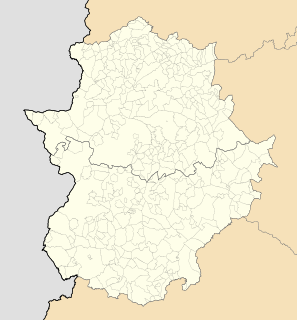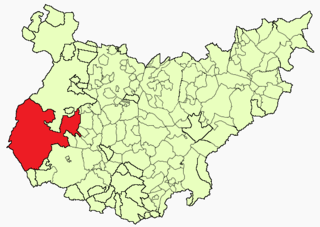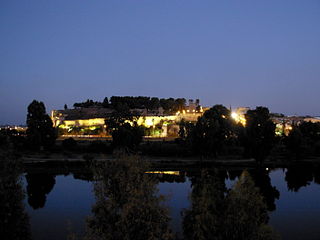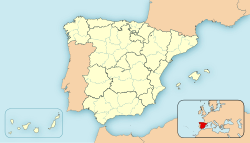
Badajoz is the capital of the Province of Badajoz in the autonomous community of Extremadura, Spain. It is situated close to the Portuguese border, on the left bank of the river Guadiana. The population in 2011 was 151,565.

Extremadura is an autonomous community of Spain. Its capital city is Mérida. Located in the central-western part of the Iberian Peninsula, it is made up of the two largest provinces of Spain: Cáceres and Badajoz. Extremadura is bordered by Portugal to the west and by the autonomous communities of Castile and León (north), Castilla–La Mancha (east) and Andalusia (south). Its official language is Spanish.

The province of Badajoz is a province of western Spain located in the autonomous community of Extremadura. It was formed in 1833. It is bordered by the provinces of Cáceres in the north, Toledo, Ciudad Real in the east, Córdoba in the south-east, Seville, and Huelva in the south and Portugal in the west.

Olivenza or Olivença is a town situated on a disputed section of the Portugal–Spain border. Its territory is administered by Spain as a municipality belonging to the province of Badajoz, and to the wider autonomous community of Extremadura. Portugal does not recognise Spanish sovereignty over the territory, based on its interpretation of the rulings of the 1815 Congress of Vienna. Spain accepted the Treaty on 7 May 1817; however, Olivença and its surroundings were never returned to Portuguese control and this question remains unresolved and Portugal holds a claim over it.

Azuaga is a town located in the province of Badajoz in southern Extremadura, bordering the Andalusian provinces of Seville and Córdoba in Spain. Azuga is 140 km from Badajoz, 125 km from Córdoba, and 140 km from Seville, in the foothills of Sierra Morena in the frontier region of Campiña Sur.

The Spanish Renaissance refers to a movement in Spain, emerging from the Italian Renaissance in Italy during the 14th century, that spread to Spain during the 15th and 16th centuries.

Sigüenza is a city in the Serranía de Guadalajara comarca, Province of Guadalajara, Castile-La Mancha, Spain.

Táliga (Spanish: [ˈtaliɣa] or Talega is a town and municipality located border area between Portugal and Spain. Like Olivenza, Táliga is part of the province of Badajoz, in the Spanish autonomous community of Extremadura, although this is disputed and unrecognized by Portugal, which considers Táliga as being de jure part of the occupied concelho of Olivenza since 1801.

Almendral is a municipality located in the province of Badajoz, Extremadura, Spain. According to the 2004 census (INE), the municipality has a population of 1352 inhabitants.

Cordobilla de Lácara is a municipality located in the province of Badajoz, Extremadura, Spain. According to the 2005 census (INE), the municipality has a population of 1023 inhabitants.

Fuente de Cantos is a municipality located in the province of Badajoz, Extremadura, Spain.

Llerena is a municipality located in the province of Badajoz, Extremadura, Spain. According to the 2007 census (INE), the municipality has a population of 5,995 inhabitants. Llerena, a town that declared itself a Historical Artistic gathering on December 29, 1966, is located in southwestern Spain. The head of the judicial and economic center of the Region of the country of the same name, it is equidistant from 20 municipalities, and sits at the confluence of the District 432 and 413 National Roads.

Sierra Suroeste is a comarca located in southwestern province of Badajoz in the autonomous community of Extremadura, western Spain. Its capital and largest city is Jerez de los Caballeros.

Llanos de Olivenza is a comarca in the province of Badajoz in the autonomous community of Extremadura, western Spain. It borders with Portugal in the west.

The Royal Chapel of Granada is an Isabelline style building, constructed between 1505 and 1517, and originally integrated in the complex of the neighbouring Granada Cathedral. It is the burial place of the Spanish monarchs, Queen Isabella I and King Ferdinand, the Catholic Monarchs. Apart from these historical links, this building also contains a gallery of artworks and other items associated with Queen Isabella.

The First siege of Badajoz was a siege carried out during the Peninsular War on the Spanish town of Badajoz, by the French general Soult.

The Alcazaba of Badajoz is an ancient Moorish citadel in Badajoz, Extremadura, western Spain. The alcazaba as it now appears was built by the Almohads in the 12th century, although it probably existed from the 9th century, when Badajoz was founded. In the 11th and 12th centuries it was the residence of the rulers of the taifa of Badajoz.

Ourense Cathedral is a Roman Catholic church located in Ourense in northwestern Spain. Dedicated to St Martin, it was founded in 550. The first structure was restored by Alonso el Casto. The present mainly Gothic building was raised with the support of Bishop Lorenzo in 1220. Its local patroness is Saint Euphemia. There is a silver-plated shrine, and others of St Facundus and St Primitivus. The Christ's Chapel was added in 1567 by Bishop San Francisco Triccio. It contains an image of Christ, which was brought in 1330 from a small church on Cape Finisterre. John the Baptist's Chapel was created in 1468 by the Conde de Benavente. The Portal of Paradise is sculptured and enriched with figures of angels and saints, while the antique cloisters were erected in 1204 by Bishop Ederonio. The Capilla de la Maria Madre was restored in 1722, and connected by the cloisters with the cathedral. The eight canons were called Cardenales, as at Cathedral of Santiago de Compostela, and they alone did services before the altar; this custom was recognised as "immemorial" by Pope Innocent III, in 1209. The cathedral, which has undergone an impressive transition of architectural styles of Romanesque, Gothic, Renaissance, Baroque and Neoclassical, was built to a Latin Cross plan. It has been a functional basilica since 1887. The cathedral has a crucifix that is held in great reverence all over Galicia.
The Siege of Olivenza was a siege carried out between 19 January and 22 January 1811 during the Peninsular War on the Spanish-controlled town of Olivenza, by the French general Soult.
Bartolomé Martinez Menacho y Mesa (Mechado) was a Roman Catholic prelate who served as Archbishop of Santafé en Nueva Granada (1593–1604) and Bishop of Panamá (1587–1593).















